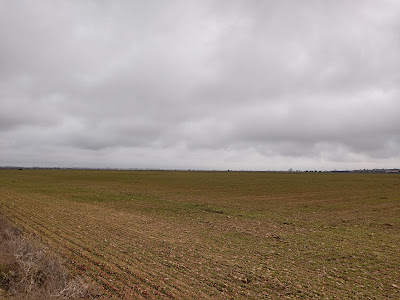I was the second one to leave the municipal albergue in Ages around 07:45. It was still dark out. I proceeded down the road to Atapuerca. Outside Atapuerca, there is a UNESCO archeological site where hominids from over a million years ago are being dug up. I stopped to refill my water jug at the fountain in Atapuerca, and watched the Spanish guy who was speeding ahead of me miss the sign to turn off the road to the left onto a dirt path. He was out of shouting distance, so I figured he'd just have to figure out his mistake.
Next, it was a climb up a hill with sharp and loose rocks. There must have been sheep grazing there at one point because there was a fair amount of sheep droppings amongst the rocks. After reaching the summit of the hill, it was downhill towards a quarry and then down into the quiet town of Cardenuela Rio Pico.
From there, I walked further downward toward Burgos. First, I had to walk along the fence of the airport. Then it was miles of walking through an industrial district. There was a Gala factory that makes ceramics like sinks, toilets, and bidets. Then there was a Bridgestone tire factory that smelled like burning rubber. There were also alot of car repair shops and car dealers. As I exited the industrial area, there was a McDonalds right on the Camino de Santiago. It was 12:45, so I went in and got lunch: a quarter pounder, potato wedges, large Coke, and an Oreo shake. It was okay, but did not taste the same as the McDonalds back home.
After lunch, it was city walking. I had to stop to cross streets and deal with pedestrians and cars as I headed to the old part of Burgos. Eventually I made it to the Burgos Cathedral. My guide book said it was free to enter on Tuesdays after 16:30. Since I still had an hour until 16:30, I continued walking until I got to Hotel Abadia near the University of Burgos. I kept waking up at the albergue in Ages last night, so I needed to get a good night sleep in a real bed. I checked in, showered, and then took a taxi back to the Burgos Cathedral at 17:00 to get my credencial stamp and tour the inside. While inside, I saw the Spanish guy who missed the cut off early in the morning. We waved to each other.
The taxi that dropped me off told me there was a taxi station somewhere near a bridge. Since international calls from my phone are expensive, I did not want to call a taxi. I'd have to find the taxi station. I wandered out of the old part of the city to the east for twenty minutes and by some miracle found two taxis idling near a bridge. I got a ride back to the hotel.
There was a Telepizza about a block from my hotel, so I got the individual menu again: a pizza with onions and green peppers, cheese sticks, and a Coke.
 |
| The archeological site near Atapuerca. |
 |
| Entering Burgos. |
 |
| McDonald's, I'm lovin' it. |
 |
| The retablo of the cathedral. |
 |
| The dome of the Burgos Cathedral. |
 |
| Burgos. |








































